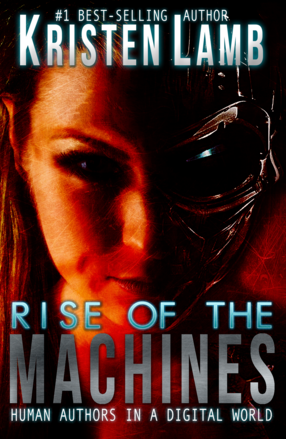Almost any of us who decided one day to get serious about our writing, read Stephen King’s On Writing. Great book, if you haven’t read it. But one thing King tells us we writers must be willing to do, is that we must be willing to, “Kill the little darlings.”
Now, King was not the first to give this advice. He actually got the idea from Faulkner, but I guess we just took it more seriously when King said it…because now the darlings would die by a hatchet, be buried in a cursed Indian filing cabinet where they would come back as really bad novels.
…oops, I digress.
Little darlings are those favorite bits of prose, description, dialogue or even characters that really add nothing to the forward momentum or development of the plot.
To be a great writer, you would be wise to learn to look honestly at all little darlings. Why? Because they are usually masking critical flaws in the overall plot. Today we will address two especially nefarious writing hazards that like to lurk below the wittiest dialogue and most breathtaking description:
Hazard #1—Mistaking Melodrama for Drama
Hazard #2—Mistaking Complexity for Conflict
These two related booby-traps are often hidden beneath our little darlings (clever dialogue, beautiful description, etc). That is probably why Stephen King recommended we kill them. Yes, kill them dead. No burying them in the Pet Semetary, also known as “revision.” Killing means killing….as in delete forever. Or at least cut them cleanly from the story and hide in a Word folder to give yourself time to grieve and move on with the real novel. Yet too many times we hang on to those favorite characters or bits of dialogue, reworking them and hoping we can make them fit…at the expense of the rest of the story.
Th-they come back….but *shivers* they are…different.
Let me explain why it is important to let go.
Hazard #1—Mistaking Melodrama for Drama
Drama is created when a writer has good characterization that meets with good conflict. Good characterization is what breathes life into black letters on a white page, creating “people” who are sometimes more real to us than their flesh and blood counterparts. The problem is that characterization is a skill that has to be learned, usually from a lot of mistakes. Yet, time and time again, I see writers—as NY Times Best-Selling Author Bob Mayer would say—moving deck chairs around on the Titanic. In a last ditch attempt to spare a darling, a writer describes the character more, or gives more info dump or more internal thought, or more back story, yet never manages to accomplish true characterization. So, when something really bad happens, we the reader just don’t care.
Les Edgerton, in his book Hooked explores this problem in detail if you would like to read more, but to keep it short and sweet I’m going to explain it this way.
Most of us have driven down a highway at around rush hour, so picture this scenario. We notice emergency lights ahead. The oncoming traffic lane is shut down and looks like a debris field. Four mangled cars lay in ruins, surrounded by somber EMTs. Do you feel badly? Unless you’re a sociopath, of course you do.
Now…
You look into that same oncoming lane and two of the cars you recognize. They belong to friends you were supposed to meet for dinner.
Before you cared…now you are connected.
That is how good characterization makes the difference. If you open your story with this gut-wrenching scene in a hospital where someone is dying, you are taking a risk. We will certainly care on a human level, but not on the visceral level that makes us have to close the book and get tissue.
Yet, I have had to pry many, many darlings like these away from desperate writers “parents” unwilling to take the scenes off of life support. They wrote opening scenes of car accidents and hospitals and death and child abduction so vivid they couldn’t read their own work without tearing up. The problem, however, was this…no one but them cared. They hadn’t done enough development of the story to make the readers just as vested as they were. And, because they were so determined to keep these gut-wrenching scenes, they never dug in and did the real work that would have made the audience cry too.
Hazard #2—Mistaking Complexity for Conflict
Complexity is easily mistaken for conflict. I witness this pitfall in most new novels. In fact, back in April at the DFW Writer’s Workshop Conference, I had an opportunity to talk to a lot of new and hopeful writers in between classes I was teaching. I would ask them what their book was about and the conversation would sound a bit like this:
What’s your book about?
Well, it is about a girl and she doesn’t know she has powers and she’s half fairy and she has to find out who she is. And there’s a guy and he’s a vampire and he’s actually the son of an arch-mage who slept with a sorceress who put a curse on their world. But she is in high school and there is this boy who she thinks she loves and…
Huh? Okay. Who is the antagonist?
*blank stare*
What is her goal?
Um. To find out who she is?
These conversations actually made me chuckle because now I know what Bob Mayer felt like the day he met me :D. My first novel was so complex, I don’t even think I fully understood it.
But back to the conference. Most writers wanted to land an agent, yet, out of everyone I talked to, only two could state what their novel was about in three sentences or less. The tragic part is that most of the novels did not have a genuine conflict lock. Protagonist wants this. Antagonist wants that. What they each want is destined to lock in conflict. Great tactic taught by Bob Mayer in his Novel Writer’s Toolkit.
It is my opinion that all these writers, deep down, knew they were missing the backbone to their story—CONFLICT. I think they sensed it on a sub-conscious level and that is why their plots grew more and more and more complicated. They were trying to fix a structural issue with Bondo putty and duct tape and then hoping no one would notice.
The problem is, complexity is not conflict.
You can create an interstellar conspiracy, birth an entirely new underground spy network, resurrect a dead sibling who in reality was sold off at birth, or even start the Second Civil War to cover up the space alien invasion…but it ain’t conflict. Conflict is biblical, and never changes. It most often revolves around the Seven Deadly Sins in conflict with the Seven Heavenly Virtues. Interstellar war, guerilla attacks, or evil twins coming back to life can be the BACKDROP for conflict, but alone are not conflict. And, yes, I learned this lesson the hard way.
Little darlings are often birthed from us getting too complex. We frequently get too complex when we are trying to b.s. our way through something we don’t understand and hope works itself out. Um, it won’t. Tried it. Just painted myself into a corner. But we get complex to hide our errors and then we risk falling so in love with our own cleverness—the subplots, the twist endings, the evil twin—that we can sabotage our entire story.
I sincerely believe these little darlings are like fluffy beds of leaves covering pungee pits of writing death. Be truthful. Are your “flowers” part of a garden or covering a grave? We put our craftiest work into buttressing our errors, so I would highly recommend taking a critical look at the favorite parts of your manuscript and then get real honest about why they’re there.
And then kill them dead and bury your pets for real.
Happy writing!
Until next time…
The demands on the 21st Century Writer are INSANE! How can we manage it all? Do we have to blog? Yes. But what do we blog about? How do we still have time left over to write great novels? Let me show you how. We Are Not Alone–The Writer’s Guide to Social Media is a fun, simple guide to social media success, written for writers, by a writer. My goal is to change your approach, not your personality.









6 comments
1 ping
Skip to comment form
Lovespell and lying in a fetal position. (Drop mic…walk offstage)
It was turn-of-the-century taste maker Arthur Quiller-Couch, who coined it in his 1916 treatise “On Writing.”
“Whenever you feel an impulse to perpetrate a piece of exceptionally fine writing, obey it—whole-heartedly—and delete it before sending your manuscript to press. Murder your darlings.” -Quiller-Couch.
A truly unique fellow. He went by the name Q and would probably be writing a blog not unlike your own if he lived today.
Author
Thanks Micah. Yeah, I looked for the origins and came up with Faulkner, but that doesn’t surprise me someone else said it even earlier. Wasn’t it T.S. Eliot who said, “Good writers borrow. Great writers steal”? LOL.
Awesome post, thanks. I especially like the “flowers covering the grave” part. It really makes a writer think!
Oh boy. Now I have to aspire to be a literary kleptomaniac!
Old university quote on publication of a paper:
Less reputable colleague, “I wish I’d said that.”
Author, “I’m sure you will.”
Brilliant post and I love the picture lol!
[…] could do as Kristen Lamb suggests and ruthlessly delete them. That certainly “kills the little darlings.” Of course, if you’re like me, you […]